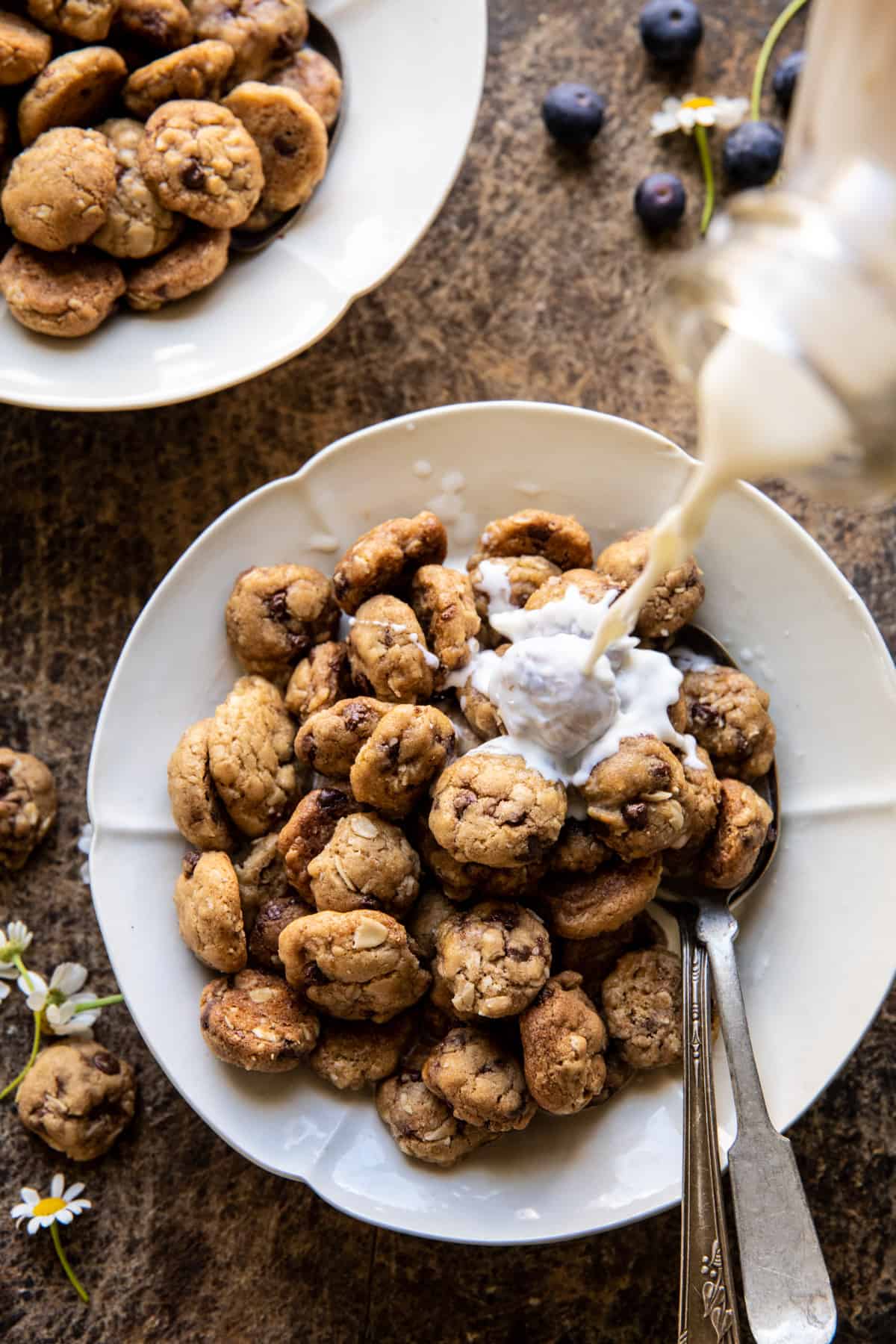
Product Details
Better than store-bought Homemade Oatmeal Chocolate Chip Cookie Crisp Cereal.so much better than the boxed stuff! This cereal is crunchy, sweet, and heavy on those chocolate chips…just like a good chocolate chip cookie, but in cereal form. Every bite is roll your eyes back good. It’s best enjoyed any time of day…with milk, as an ice cream topping, or simply by the handfuls.other than the fact that cereal is something you can grab, eat, and enjoy without cooking or preparing a thing. Which makes me think that cereal is a good spring/summer food. It allows you to get outside as fast as you can. Which was always my goal growing up!
Bad things in big company cereal
Sugar: Many kid cereals are high in sugar or high fructose corn syrup (HFCS), which is also called corn syrup or corn sugar. Generally, if you see “sugar” of any kind in non-organic products or GMO cereal, very likely it’s HFCS.
GMOs: Most conventional cereals contain sugar and corn made from GMO products. Note that these same manufacturers create GMO-free cereals for distribution overseas. Most GMOs are sprayed with glyphosate, an herbicide known to cause cancer, so avoiding GMOs also helps you avoid glyphosate residue on your food.
Glyphosate: Glyphosate is the most popular herbicide in the world and the active ingredient in Monsanto’s Roundup weed killer. It’s sprayed on over 200 different crops. You’ll especially find the residue inside wheat, legume, and oat products. In August 2018, EWG scientists posted a study analyzing the most popular breakfast cereals and their levels of glyphosate. Glyphosate is very problematic and has been deemed a “probable carcinogen” by the World Health Organization. It’s also been added to California’s Prop. 65 list of known carcinogens and reproductive toxins.
Artificial Food Dyes: Artificial food dyes are not needed in cereal and they are very dangerous to small children. In fact, the American Academy of Pediatrics has warned parents about the perils of artificial food dyes and other such food additives.
Hydrogenated Oils: Partially hydrogenated oils contain trans fats, which, as we’ve discussed before, are linked to cancer, heart disease, and immune problems. Fully hydrogenated oils are full of saturated fat. In addition, some companies will label partially hydrogenated oils as just “hydrogenated oils”, so you can’t be sure if there is trans fat in the product. (If there are less than 0.5 grams of trans fat per serving, companies are allowed to write “0 grams of trans fat.”)
Soy Lecithin: Derived from GMO soy, this additive often contains toxins. According to The Cornucopia Institute, soy lecithin processing often involves hexane, and, though it is removed during processing, trace amounts can be left behind. That residue is unregulated by the Food and Drug Administration even though it is listed by that organization as a potential carcinogen and neurotoxin.
Annatto: This natural flavoring is now entering into controversy. According to WebMD, annatto can affect blood sugar levels, so if your child has diabetes, please be aware of that. It also has been linked with allergies, and the Food Intolerance Network has gotten reports linking it to headaches and irritability. If you have a sensitive eater or a child prone to allergies, you may want to avoid this flavoring.
BHT: Found in many cereals, this food is classified by U.S. law as “GRAS” (generally recognized as safe). This means that experts consider them safe and they are approved as food additives without additional testing of their effects. In 2014, the National Resources Defense Council (NRDC), an environmental safety watchdog group, released the “Generally Recognized as Secret: Chemicals Added to Food in the U.S.” report. This report found loopholes in the GRAS classification, including research data coming from the company themselves and expert opinions that disregarded evidence of allergic reactions, that compromise the real safety of GRAS additives. BHT is also a chemical additive and may be a possible ADHD trigger.
BHA: Another GRAS additive, BHA has been linked to cancer in some studies. The National Institutes of Health’s National Toxicology Programs has concluded that it can be “reasonably anticipated to be a human carcinogen.” Both BHA and BHT are said to be at low enough levels to meet safety standards for consumption by the FDA
Care & Maintenance
To maintain the beauty and integrity of your purchase, we recommend treating it with care. Simple maintenance practices, such as gentle washing and proper storage, can effectively preserve the longevity of your favorites. We encourage you to refer to the care instructions included with each item, designed to help you keep your purchase in top condition.
Size & Fit
Our products are crafted to fit true to size, ensuring that you can confidently select your usual size with ease. Whether you’re looking for a relaxed or tailored fit, our designs are made to complement your unique shape and style.















